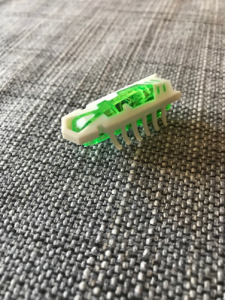Hexbug Maze
In this activity, we will create a Hexbug maze using straws, popsicle sticks, tape, and poster board! This fun activity not only allows young children to deepen their understanding of spatial relationships by connecting words, actions and symbols, but also gives them opportunities to build and problem solve. Many young children understand concepts related to position and spatial relationships before they have the language to describe them. In this game, we are going to explore spatial relationships by connecting words (before, after, behind, inside, outside, under) with actions.
If you’ve never heard of Hexbugs, they are basically very affordable micro robots. You can buy as singles or in bulks (depending on where you are purchasing from).

Materials:
- Hexbug Nano
- Poster board
- Some cardboard tubes from wrapping paper rolls.
- Popsicle sticks
- Straws
- Tape
Directions:
- Design a maze for your hexbug!
- It needs to have one entrance, one exit, walls and several paths, one straight section, and few bends where the bug makes a large change in direction (makes a big turn).
- Use either clothespins, popsicle sticks, or straws to create the walls and paths in your maze based on your design.
- You can tape the materials you are using on the board when building your maze.
Once you build your maze based on the directions, it is time to put it to a test!

To help children practice spatial relationships, encourage them to narrate hexbug’s movements. For example, you might say, “Look, he is turning right,” “It is going under the bridge,” “It is inside the tunnel now,” “It is going over the bridge.” You can take turns narrating the movements and directions the hexbug takes. To keep it interesting and fun, try revising your maze and see if you can use other other concepts related to position and spatial relationships.
I really love this idea for children. I think it is just so fun and creative and really will help them with problem solving and also with them using there words.
Ive never heard of a hexbug! Very cool!!